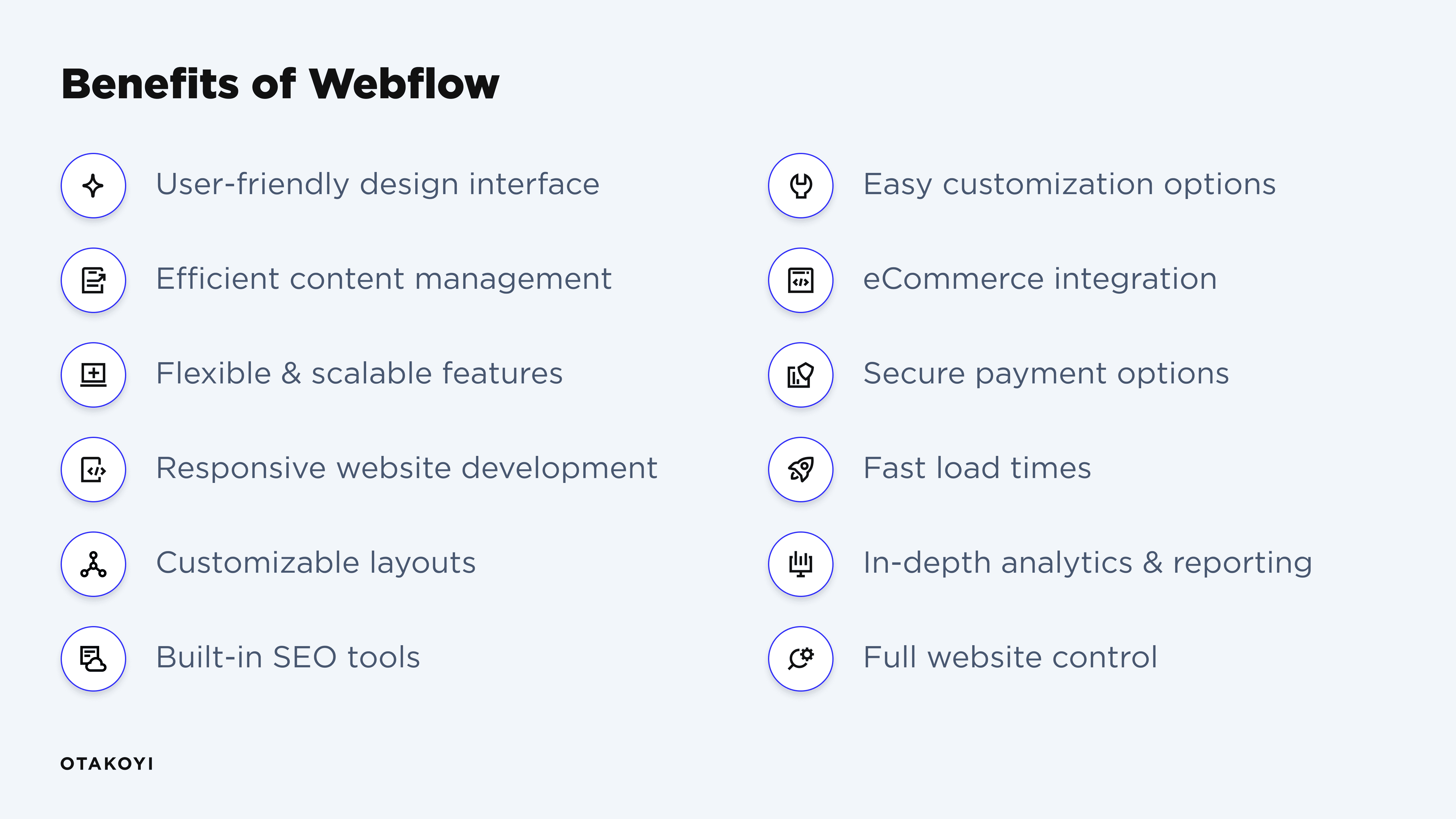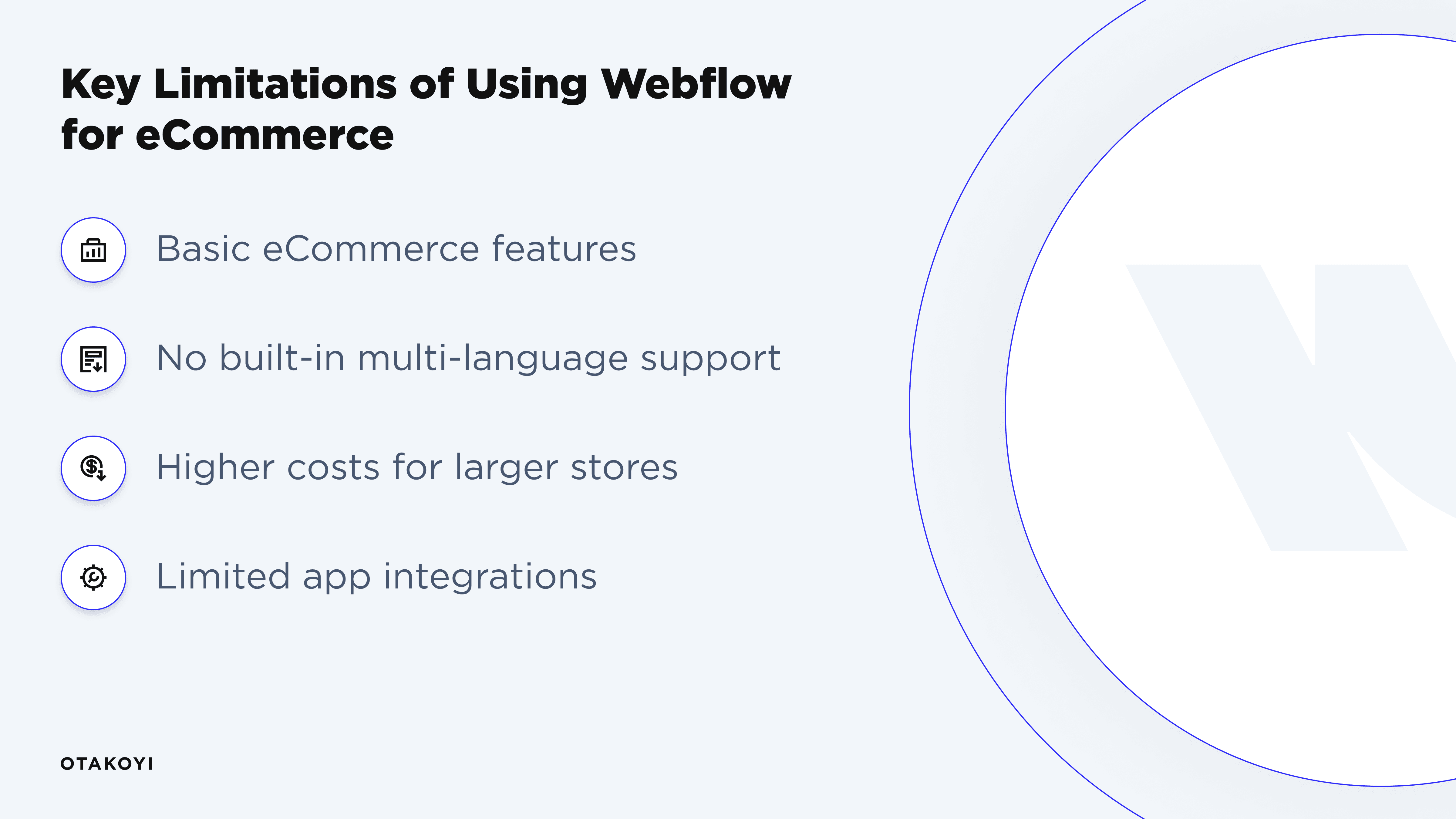As you are reading this article, you’ve caught yourself thinking it’s time to improve your eCommerce online presence. Want to feel even more motivated? According to Statista Report, global retail eCommerce sales reached an estimated 5.8 trillion U.S. dollars in 2023. The growth rate is predicted to reach 39% over the coming years. So, it means that it is expected to surpass 8 trillion dollars by 2027. Exciting, right?
And, if you’re interested in Webflow for online stores, we are here to help you find out more about its functionality, design freedom, and easy-to-use tools. This article aims to uncover key insights and benefits of Webflow for companies looking for more from their online stores. Of course, we’ll pinpoint the kinds of companies that might profit most from utilizing this platform in more detail. Get ready for the journey of Webflow tips!
What are the Key E-Commerce Features Webflow Provides?

There are various features that Webflow for eCommerce provides. However, some of them stand out the most as they are those that make it different from other platforms available. We would like to provide you with its distinct peculiarities. So, let’s tackle this!
1. Fully customizable storefronts
You get a chance to design every aspect of your store without any restrictions and completely to your liking.
2. Responsive design
The platform is great if you are looking for a way to automatically adjust your website for mobile, tablet, and desktop views.
3. Product management
This seems a jackpot for eCommerce owners as you can easily add, edit, and organize products with images, descriptions, categories, and custom fields. User-friendly for both customers and business runners.
4. Flexible product options
Webflow offers multiple options like size, color, or material for each product you are to include.
5. Secure payment options
It is not surprising yet a fact that it supports multiple payment gateways such as Stripe, PayPal, and Apple Pay, complying with security standards.
6. Automatic tax calculations
This is an excellent feature for those stores that go globally. You can calculate taxes based on customer location.
7. Abandoned cart recovery
This is a great client support feature that automatically sends reminder emails to customers who leave items in their carts.
8. SEO optimization
We know well that we can’t do without an efficient SEO. Thus, Webflow provides built-in tools to optimize your store for the key search engines.
9. CMS integration
As a part of optimization features, Webflow makes it possible to manage content like blogs or product descriptions easily alongside e-commerce stores.
10. Analytics and reporting
Data analysis and conclusions you can make from that are integral nowadays. Using Webflow, you track sales, monitor performance, and gain insights with detailed analytics and reporting options.
As you can see, Webflow brings something every eCommerce owner dreams about – simplified management and sleek outcomes. As a matter of fact, these features represent the benefits you get when developing an e-commerce website with Webflow. Let’s not rush into things as we are about to explore more in the next section.
Webflow for E-Commerce: The Benefits It Brings
As you could’ve already explored, Webflow for eCommerce offers numerous benefits that make it a solid choice for businesses. Based on our experience and particular Webflow project examples, we’d like to share its benefits and what it brings to make stunning websites.
Designing user-friendly interface
Webflow enables you to create an intuitive, visually appealing, and easy-to-navigate online store. Guess what. With such a visual interface, your customers enjoy a smooth shopping experience.
Conducting efficient and successful content management
Thanks to Webflow, e-commerce stores get access to integrated CMS. What does it bring? To put it simply, managing content like product descriptions, blogs, and media becomes a breeze. It allows for streamlined updates and ensures your store remains fresh and relevant.

Transform your online store with Webflow today!
Contact usDesigning features with flexibility and scalability in mind
Webflow for eCommerce allows you to build scalable stores that can grow alongside your business. Its flexibility ensures you can quickly adapt to changing needs without extensive redesigns.
Developing responsive websites
Webflow's built-in responsive design features are distinct in this website builder. They do make sure that e-commerce websites look and function flawlessly on all devices and screen sizes. And we are speaking about desktops, tablets, and mobile phones. As a result, this platform offers a seamless customer experience.
Involving flexible and customizable layouts
With Webflow, you're not limited by rigid e-commerce templates. You can customize every aspect of your store's layout, creating a unique design that reflects your brand’s identity and strong selling points.
Using built-in SEO tools and options
SEO is crucial for e-commerce success, and Webflow offers robust, built-in SEO tools. You can optimize meta tags, images, and content to ensure your store ranks well in search engine results and reaches your target audience.
Developing with easy customization features
Customizing elements like product pages, checkout forms, and promotional banners is easy with Webflow’s intuitive editor. We can assure you it comes with the possibility to make any adjustments you need to your unique design preferences without extensive coding.
Integrating eCommerce features with ease
Webflow provides another advanced eCommerce feature - the integration of essential functions, such as secure payments, shipping options, and product management, making it user-friendly for business owners.
Implementing highly secure payment options
Security of the entire checkout process is vital for any online store. Of course, Webflow integrates with trusted payment providers like Stripe, PayPal, and Apple Pay to ensure secure operations and no hidden transaction fees.
Providing SSL encryption
Webflow offers built-in SSL encryption for all websites, giving customers peace of mind by securing their data during online transactions. So, dear users, you may eagerly make your online purchases on online stores built on Webflow, as the checkout flow is completely secure.
Boosting load times
Webflow ensures your site loads quickly, critical for user experience and conversions. Fast loading times help reduce bounce rates and improve overall site performance.
Conducting thorough analytics and reporting
Webflow provides robust analytics and reporting features, allowing you to monitor key metrics like sales performance, customer behavior, and product success, helping you make data-driven decisions.
Having full control over your website
With Webflow, you have complete control over the design, content, and functionality of your e-commerce store. This level of customization options ensures that your website truly represents your brand.
Integrating customer support
Webflow allows seamless integration of customer accounts and support tools. As a result, it makes it easier to provide timely assistance to clients, be it through live chat, emails, or helpdesk systems.
What Limitations Come in Place When Using Webflow for eCommerce

Although many people find Webflow for eCommerce to be a robust platform, it has certain limitations that may be restrictive depending on the size and complexity of your e-commerce business. Below, we will provide you with some of the most typical issues that Webflow users may run into.
#1 Limited payment gateways
Only a few payment gateways, including Stripe, PayPal, and Apple Pay, are supported by Webflow. This could be a disadvantage for companies that need more specialized or unconventional payment methods. Nevertheless, external integrations such as Foxy.io can aid in broadening these choices.
#2 Basic eCommerce features
Although Webflow has sufficient eCommerce features for small to medium-sized businesses, it lacks advanced features like sophisticated inventory management, support for multiple currencies, and intricate shipping regulations. Large companies with more intricate requirements may find these restrictions annoying.
#3 No built-in multi-language support
For international e-commerce businesses, the lack of native multi-language functionality can be a significant challenge. Webflow requires third-party tools like Weglot or manual solutions to offer multiple languages, adding more work and cost.
#4 Higher costs for larger stores
The pricing plans offered by Webflow are appropriate for small businesses, but as they grow, expenses may mount up rapidly. Webflow may get pricey compared to other platforms, with more affordable prices for big retailers with lots of products and heavy traffic.
#5 Limited app integrations
Webflow does not have such a wide range of integrated apps like other sites. Companies may have to depend on outside resources or a custom development process if they want to improve robust e-commerce functionality. Sometimes, it could lead to higher costs and complexity.
Who Might Benefit the Most from Choosing Webflow for Their E-commerce Projects?
Webflow is not a one-size-fits-all platform but caters exceptionally well to certain types of businesses. Let’s discover who stands to benefit the most from choosing Webflow for eCommerce projects.
#1 Small to medium-sized businesses
You should definitely consider Webflow if you own a small or medium-sized business. This website builder is easy to use, combined with its robust design capabilities, which makes it ideal for such companies. So, if you don’t need complex e-commerce features but still want a custom and professional site - you’ve reached the right address with Webflow.
#2 Design-focused brands
What if you have a business that prioritizes design and branding? We have great news for you as well! You will definitely appreciate Webflow’s flexibility and the design tools it offers. What do you get? Complete customization, full control over the appearance and feel of online stores, and distinct brand awareness.
#3 Startups
Startups, we do know your struggles! Always about timely solutions and tight budgets. So, if you are looking for a quick and cost-effective way to get your e-commerce platform up and running, be sure that you can benefit from Webflow's no-code capabilities and straightforward setup process. Sounds amazing, don’t you think?
#4 Content-driven stores
Are you here, dear gentle bloggers? Make sure you don’t miss out on this part, as Webflow’s CMS integration makes it easy to manage dynamic content like blogs, product descriptions, and media. Of course, you don’t need to be a blogger specifically, but most businesses require frequent updates. That is why it makes Webflow a significant advantage.
What Do Our OTAKOYI Specialists Say About Webflow for eCommerce?

#1 Artem Stasiiev, Webflow developer:
Webflow is a great platform for developers who want design flexibility without getting bogged down by code-heavy processes.
#2 Marian Slavytch, Head of Design Department:
Webflow stands out for its intuitive design capabilities. I appreciate how it gives me full control over the look and feel of a store without compromising on responsiveness and functionality.
#3 Elmira Darybogova, Content manager:
Webflow’s CMS integration, in my humble opinion, is ideal for managing dynamic content. Hence, eCommerce stores need frequent updates, it is really easy to handle everything from one place.
#4 Ruslana Miz, Digital marketing specialist:
From my experience, its clean, customizable templates integrate smoothly with various marketing tools. It does help brands establish a consistent online presence.
#6 DevOps engineer:
I don’t do much on my part as Webflow is a hosted platform. It means the infrastructure management is mostly taken care of. It must be great for smaller eCommerce businesses.
#3 SEO specialist:
From an SEO perspective and my own experience, Webflow provides strong built-in tools. I love its customizable meta tags, schema markup options, and clean code structure. Everything for the organic flow!
Final Words
With complete confidence, Webflow for eCommerce has shown to be flexible, scalable, and efficient. To wrap it up, it suits perfectly well for small to medium-sized enterprises, startups, and design-focused brands because of its many built-in features. Responsive designs, customizable layouts and design templates, secure payment gateways, integration options, and many more. Even though there are some drawbacks, everything can be addressed and solved using third-party integrations. We can’t help but state the obvious - all these benefits make Webflow a viable option for an online business.
Would you like to have such an aesthetically stunning, content-driven, and custom eCommerce website? Our OTAKOYI team is here to navigate you through the options and help make the best yet informed decision when you're considering using Webflow.





